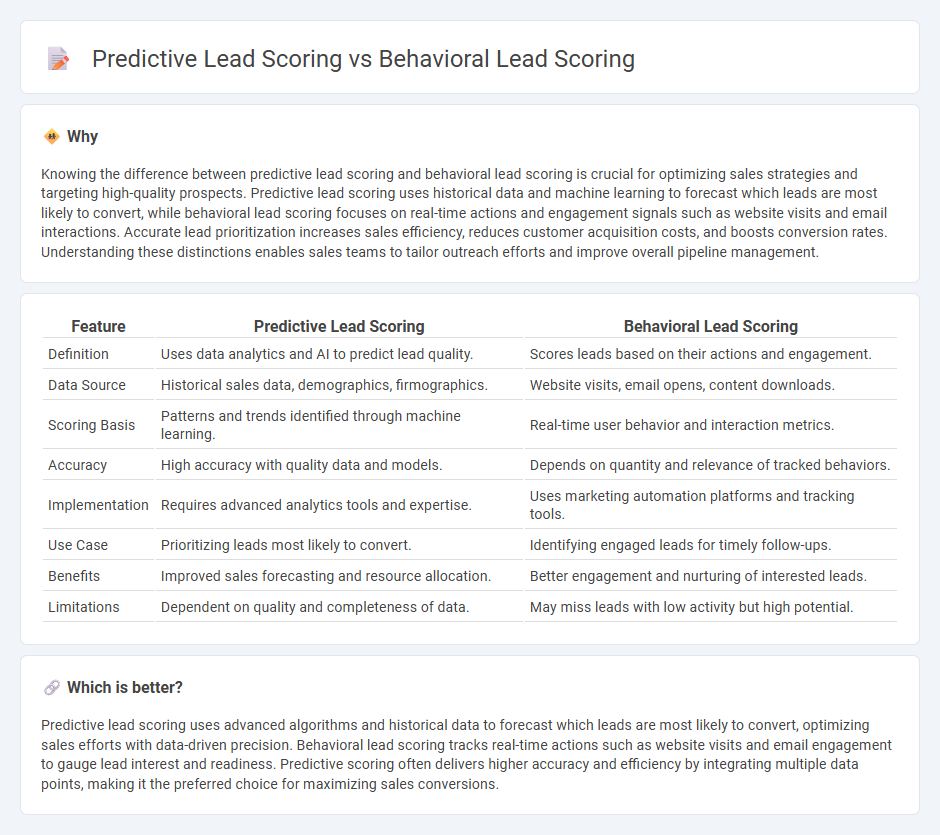
Predictive lead scoring leverages machine learning algorithms and historical data to assign scores based on the likelihood of lead conversion, enhancing sales efficiency. Behavioral lead scoring focuses on tracking and analyzing specific actions, such as website visits and email interactions, to rank leads according to engagement levels. Explore the distinct advantages of each method to optimize your sales strategy effectively.
Why it is important
Knowing the difference between predictive lead scoring and behavioral lead scoring is crucial for optimizing sales strategies and targeting high-quality prospects. Predictive lead scoring uses historical data and machine learning to forecast which leads are most likely to convert, while behavioral lead scoring focuses on real-time actions and engagement signals such as website visits and email interactions. Accurate lead prioritization increases sales efficiency, reduces customer acquisition costs, and boosts conversion rates. Understanding these distinctions enables sales teams to tailor outreach efforts and improve overall pipeline management.
Comparison Table
| Feature | Predictive Lead Scoring | Behavioral Lead Scoring |
|---|---|---|
| Definition | Uses data analytics and AI to predict lead quality. | Scores leads based on their actions and engagement. |
| Data Source | Historical sales data, demographics, firmographics. | Website visits, email opens, content downloads. |
| Scoring Basis | Patterns and trends identified through machine learning. | Real-time user behavior and interaction metrics. |
| Accuracy | High accuracy with quality data and models. | Depends on quantity and relevance of tracked behaviors. |
| Implementation | Requires advanced analytics tools and expertise. | Uses marketing automation platforms and tracking tools. |
| Use Case | Prioritizing leads most likely to convert. | Identifying engaged leads for timely follow-ups. |
| Benefits | Improved sales forecasting and resource allocation. | Better engagement and nurturing of interested leads. |
| Limitations | Dependent on quality and completeness of data. | May miss leads with low activity but high potential. |
Which is better?
Predictive lead scoring uses advanced algorithms and historical data to forecast which leads are most likely to convert, optimizing sales efforts with data-driven precision. Behavioral lead scoring tracks real-time actions such as website visits and email engagement to gauge lead interest and readiness. Predictive scoring often delivers higher accuracy and efficiency by integrating multiple data points, making it the preferred choice for maximizing sales conversions.
Connection
Predictive lead scoring and behavioral lead scoring are interconnected through their focus on analyzing data to prioritize sales leads effectively. Predictive lead scoring utilizes historical data and machine learning algorithms to forecast the likelihood of a lead converting, while behavioral lead scoring evaluates real-time actions such as website visits, email clicks, and content engagement to assess lead interest and readiness. Combining these approaches enhances sales efficiency by providing a comprehensive view of lead quality and enabling targeted follow-ups based on both predictive insights and observed behaviors.
Key Terms
**Behavioral Lead Scoring:**
Behavioral lead scoring prioritizes analyzing prospects' interactions, such as website visits, email opens, and content downloads, to determine their engagement level and readiness to buy. It captures real-time data to identify leads showing intent through specific actions, increasing sales teams' efficiency and targeting accuracy. Explore comprehensive strategies and tools to enhance your lead qualification with behavioral lead scoring.
Engagement
Behavioral lead scoring evaluates prospects based on their interactions and engagement activities such as email opens, website visits, and content downloads, emphasizing real-time behavioral data. Predictive lead scoring uses machine learning algorithms analyzing historical data and patterns to forecast lead quality and probability of conversion. Explore how combining these approaches can enhance your lead qualification strategy.
Activity Tracking
Behavioral lead scoring prioritizes activity tracking by analyzing specific user actions such as website visits, email opens, and content downloads to gauge engagement levels. Predictive lead scoring incorporates activity data alongside historical sales patterns and demographic factors to forecast the likelihood of conversion with advanced algorithms. Explore further to understand how integrating activity tracking enhances your lead scoring strategy.
Source and External Links
Demographic vs. Behavioral Lead Scoring in B2B Explained - Behavioral lead scoring ranks leads based on their interactions with a brand's digital assets, providing real-time insights into their interest and enabling personalized marketing approaches that adapt quickly to lead behavior changes.
Lead Scoring Examples (10 Methods, Metrics and Signals) - Behavioral lead scoring measures a lead's level of interest and buying stage by tracking engagement like email opens, clicks, responses, website visits, and demo requests to facilitate personalized follow-ups.
Lead Scoring - Adobe Experience Cloud - Behavioral lead scoring (implicit scoring) tracks prospects' online behaviors such as demo views and content downloads to differentiate active and passive buying signals, allowing scoring models to weight actions based on sales readiness.
 dowidth.com
dowidth.com